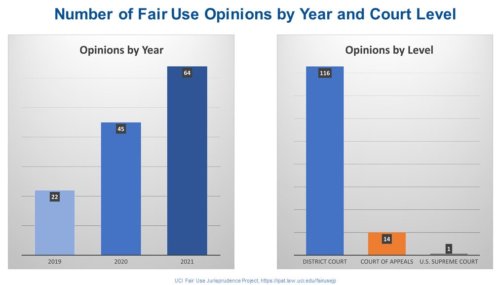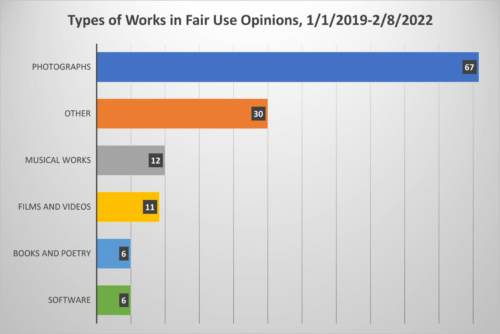Last Updated on July 9, 2022, 9:41 am ET
Last year, in celebration of Fair Use Week, the UCI Intellectual Property, Arts, and Technology (IPAT) Clinic took a deep dive into fair use. We looked at every written judicial opinion that discussed fair use from the beginning of 2019 through February 2021, and made them available in a searchable, sortable database with abstracts and commentary and links to copies of every single case. We learned a lot, and the resources we made available were used by many scholars, students, and attorneys across the country.
Click here to see the IPAT Clinic’s table of 131 case abstracts and commentary.
The fair use doctrine allows for use of copyrighted material without permission or payment for certain socially valuable purposes. It is one of the essential ways that the rights of copyright holders are balanced with the First Amendment right to free expression. Fair use is also an area of particular focus for the IPAT Clinic’s mission. We help independent filmmakers, journalists, artists, and other creators use copyrighted materials in their projects to comment, critique, and educate in ways that would be impossible without the fair use doctrine. So naturally, we had great fun delving into the interesting fact patterns and analyses across the country.
Our work last year surprised us in some interesting ways: First, fair use arguments in federal court were more common than we expected. Second, photography cases, particularly from “frequent filer” plaintiffs, accounted for a remarkably dominant share of all cases. Finally, there were surprisingly few cases dealing with technology—the days of Kelly v. Arriba Soft and Authors Guild v. HathiTrust seem to be on the decline.
For Fair Use Week 2022, we’ve returned to the Fair Use Jurisprudence Project to analyze and present another year’s worth of fair use cases. Our first observation is that the rate of fair use activity has continued to increase. We logged 64 opinions discussing fair use in 2021, increasing from 45 in 2020 and 22 in 2019. Click here for the abstracts. Photographs continue to be the most common type of work at issue in these disputes, with 67 of the 132 total cases from 2019 to 2022 relating to their use. Of course, not all photograph cases come out the same way. Online news sites, web storefronts, bloggers, and artists have all claimed fair use as a defense against photograph infringement claims, with varying results.
We also created several charts and graphs visually breaking down cases by district and court level, type of work, and other metrics we found useful. Check out our charts here.
Last year also saw a rare fair use opinion coming out of the US Supreme Court. In Google v. Oracle, the court determined that it was fair use when Google used certain code from Oracle’s Java API to facilitate development of apps by experienced Java coders. The opinion also clarified the role of the jury: the jury may determine underlying facts, but the court makes the ultimate fair use determination. And the court issued additional guidance with respect to the “market harm” factor in fair use analysis, instructing that “loss of revenue is not the whole story.” In addition to revenue, “we must take into account the public benefits the copying will likely produce. Are those benefits, for example, related to copyright’s concern for the creative production of new expression? Are they comparatively important, or unimportant, when compared with dollar amounts likely lost (taking into account as well the nature of the source of the loss)?”
Another development that bears watching is a trickle of cases that dealt with Section 512(f) and (h) of the Digital Millennium Copyright Act. Section 512 discusses safe harbors for online service providers and creates a system of notices and counter-notices for alleged infringement occurring through those providers. Section 512(f) prohibits any person from making material misrepresentations in DMCA takedown notices or counter-notices; those who do will be held liable for damages. Analysis of the misrepresentation question often involves a fair use analysis. Meanwhile, Section 512(h) allows copyright holders to subpoena online service providers for the identities of alleged infringers. When there is a motion to quash the subpoena, courts will undertake a fair use analysis to determine whether copyright infringement occurred. We logged one online service provider safe harbor case in 2021, two misrepresentation cases in 2021, and one subpoena request case each year from 2020 to 2022.
Finally, we are seeing a disturbing surfeit of cases filed against news-gathering organizations. We have identified at least 17 fair use cases in which a news-reporting organization or magazine was a defendant—ranging from small outfits like Long Island Tennis Magazine or a local public television station to massive media empires like Hearst and Sinclair. Several of these opinions found that the news-reporting purpose of the uses was not enough to render them fair use as a matter of law.
We will continue to monitor the evolution of the fair use doctrine with interest, particularly as the world of online media continues to grow. Independent creators in the online space exist in a context of constant reference and dialogue, making fair use ever more crucial to free expression.
And keep an eye out for an updated case table including all fair use opinions dating back to 2013. We expect to update the Fair Use Jurisprudence Project with this new data in the near future. We hope that an even larger data set can teach us even more about the trends and evolution of fair use.
This has been a fascinating journey and a labor of love. The authors would like to extend a great deal of thanks to all the IPAT Clinic students who worked on this project, including drafting all those case abstracts.
Editor’s note: This story was published on the UCI Intellectual Property, Arts, and Technology Clinic website on February 24, 2021.






